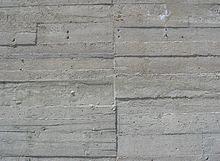Formlining

The inner surface of a formwork for concrete components is called the formwork skin . Since the fresh concrete comes into contact with the formlining, different requirements are placed on the material, which mainly depend on the desired quality of the later concrete surface.
From the beginnings of reinforced concrete construction until the second half of the 20th century, formwork made of load-bearing beams (e.g. squared timber ) with a board-nailed formwork skin was common. The use of such a board formwork can be recognized by a rough concrete surface on which the imprints of the individual boards and their wood grain can be seen.
In many cases, modern formwork still has a formlining made of wood, but formwork panels made of plywood are used, which can be additionally coated for particularly smooth surfaces. To insert the concrete surface as a design element, can Formliners be used as a scarf skin that stick to the surface patterns and shapes.
The influence of the formlining on the concrete surface is particularly important for exposed concrete . Since wooden panels show different water absorption behavior depending on the previous period of use and age, a color difference between sections with new and used formlining can be seen. This effect must be taken into account when planning the formwork, e.g. B. in that only previously used formwork panels are used for exposed concrete surfaces.
literature
- Roland Schmitt: The formwork technology . John Wiley & Sons, 2001, ISBN 3-433-01346-2 , p. 49 ff.
- Construction engineering . 10th edition. Europa-Lehrmittel, 2003, ISBN 978-3-8085-4460-0 , pp. 265 .
Web links
- Fresh concrete pressure when using self-compacting concrete (accessed on August 20, 2020)
- Formwork technology fair-faced concrete (accessed on August 20, 2020)
- Fair-faced concrete - surface design techniques (accessed on August 20, 2020)
- Understand the concrete result. (accessed on August 20, 2020)
- Applied fair-faced concrete standards, guidelines, etc. Leaflets in Austrian construction practice (accessed on August 20, 2020)
